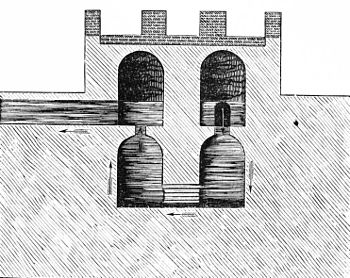filtering-places, those of the Claudia and Anio Novus were under-ground, and now appear simply as mounds. The others were above-ground, but covered over. From this point two magnificent arcades, the Marcian and the Claudian, extended to the city—the one carrying three aqueducts, the other two. They were not more than 100 yards apart, and the Marcian was 30 feet high, the Claudian 50. The filtering-places were of peculiar construction and admirable design. They consisted of four chambers, two on a level with the conduit, and two directly below (Fig. 2). The water flowing into the first descended

Fig. 2.—Section of the Piscina of the Anio Novus, at the Entrance into Rome in a Tower of the Wall of Aurelian and of the Gardens of the Sessorian Palace.
through an opening in the floor to the second, whence it flowed on through a perforated wall or grating to the third, ascending from that through an opening in the roof to the fourth, where it found its original level and reentered the conduit. A stairway descending to an opening afforded access into the chambers beneath, and by the assistance of sluice-gates the water could be turned directly from the first chamber into the fourth, so that the mud could be cleaned out of the chambers below. It is remarkable that this ingenious device for filtering has not occurred to modern aqueduct-builders, for its simplicity and utility are conspicuous.
The details of distribution are interesting, but we have not space to go far into them. There were 247 main reservoirs in the city, from which the water was distributed to 19 barracks for the use of the army, 95 public establishments, 39 theatres and places of amusement, and 591 open reservoirs for the public. That was in the time of
